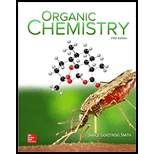
Concept explainers
(a)
Interpretation: The most stable arrangement of substituents on the six-membered ring by using chair form is to be drawn.
Concept introduction: Glucose is a monosaccharide. It is made by the plants during the process of photosynthesis. The molecular formula of glucose is
(b)
Interpretation: The chair form of glucose is to be converted into wedge-dash representation.
Concept introduction: Glucose is a monosaccharide. It is a simple sugar that is made by the plants during the process of photosynthesis. The molecular formula of glucose is
(c)
Interpretation: A constitutional isomer of glucose is to be drawn.
Concept introduction: Constitutional isomers have same molecular formula but the connectivity of the atoms is different.
(d)
Interpretation: The stereoisomer of glucose that has an axial OH group on one carbon is to be drawn.
Concept introduction: The two stereoisomers of glucose are
Want to see the full answer?
Check out a sample textbook solution
Chapter 4 Solutions
ORGANIC CHEMISTRY-MOLYMOD PACKAGE
- Shown below is Streptomycin, and Neomycin B. Circle and label as many functional groups in these molecules as you can. a. Label each chiral carbon in Streptomycin. How many total stereoisomers exist for Streptomycin? b. Label each chiral carbon in Neomycin B. How many total stereoisomers exist for Neomycin B?arrow_forwardConstruct a model in which a tetrahedral carbon atom has four different colored model atoms attached to it- red, green, orange and white representing 4 different atoms attached to the central atom. a) Does the atom have a plane of symmetry? why or why not? b) Now replace the green atom in your model with a second orange atom. Now two of the groups attached to the carbon atom are identical. Does the model now have a plane of symmetry? Describe it. c)A carbon atom has four different groups attached to the stereogenic center. Draw structural formulas for the following compound and mark stereogenic centers with as asterisk: 1-bromobutane, 2-bromobutane, 1,2-dibromobutane, 1,4-dibromobutane, 2,3-dibromobutane.arrow_forwardConsider 1,2-dimethylcyclohexane.a. Draw structures for the cis and trans isomers using a hexagon for the six-membered ring.b. Draw the two possible chair conformations for the cis isomer. Which conformation, if either, is more stable?c. Draw the two possible chair conformations for the trans isomer. Which conformation, if either, is more stable?d. Which isomer, cis or trans, is more stable and why?arrow_forward
- .Draw the strongest IMF that can form between each structure below and a water molecule. Draw a stereoisomer of each molecule below. a. HOarrow_forwardPlease answer A,B and Carrow_forwardConsider 1,2-dimethylcyclohexane. a.Draw structures for the cis and trans isomers using a hexagon for the sixmembered ring. b. Draw the two possible chair conformations for the cis isomer. Which conformation, if either, is more stable? c. Draw the two possible chair conformations for the trans isomer. Which conformation, if either, is more stable? d.Which isomer, cis or trans, is more stable and why?arrow_forward
- 4) Draw a cyclohexane chair with 2 substituents that requires a chair flip.arrow_forwardLabel the anomeric carbonarrow_forwardConsider rotation around the carbon–carbon bond in 1,2-dichloroethane (ClCH2CH2Cl). a.Using Newman projections, draw all of the staggered and eclipsed conformations that result from rotation around this bond. b.Graph energy versus dihedral angle for rotation around this bond.arrow_forward
- 1. Draw the two conformations of trans-1-bromo-3-methylcyclohexane using both the Newman projection and the chair drawing. Calculate the energies of each. What ratio of the two conformers will be present at equilibrium? 2. Draw a structure of a chiral alcohol.arrow_forwardBe sure to answer all parts. Draw the structure corresponding to each IUPAC name. a. 3,3-dimethylpentane CH₂ CH₂ edit structure... b. 3-ethyl-4-methylhexane -CH₂ CH₂ CH3 CH₂ edit structure ... CH₂ Xarrow_forward• Question 5: Label each stereogenic center as R or S. CH₂ a. CH₂CH₂ b. CH H 1 NH₂ H CH3 CH₂CH₂ T C. D CI CH3 d. Br C ICH₂ H e. f. H* HO C HOOC CH₂ HO CH(CH3)2 -C₂ C CH3 SH NH₂ H CH3 g. h. .CI CIarrow_forward
 Organic Chemistry: A Guided InquiryChemistryISBN:9780618974122Author:Andrei StraumanisPublisher:Cengage Learning
Organic Chemistry: A Guided InquiryChemistryISBN:9780618974122Author:Andrei StraumanisPublisher:Cengage Learning
